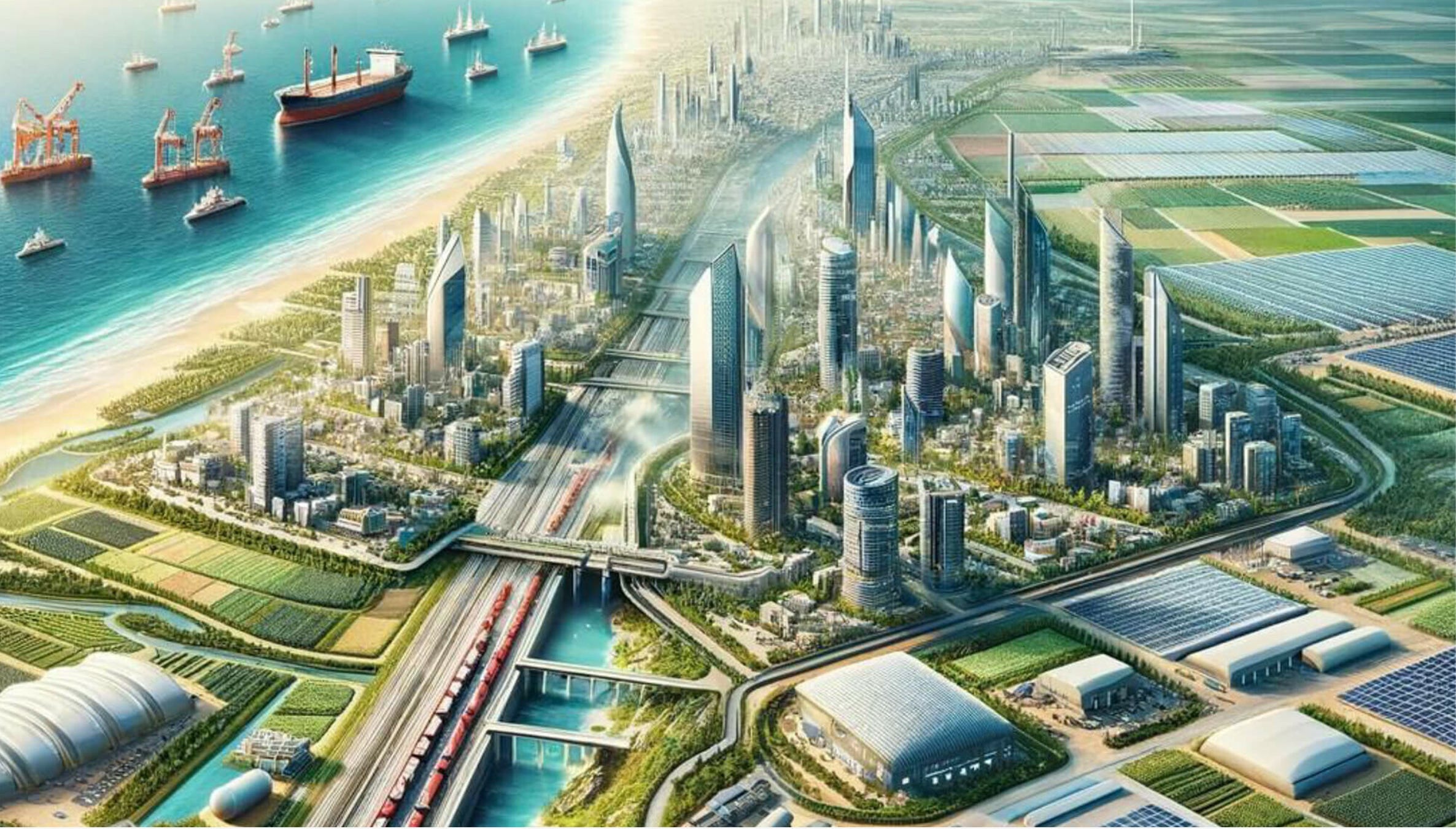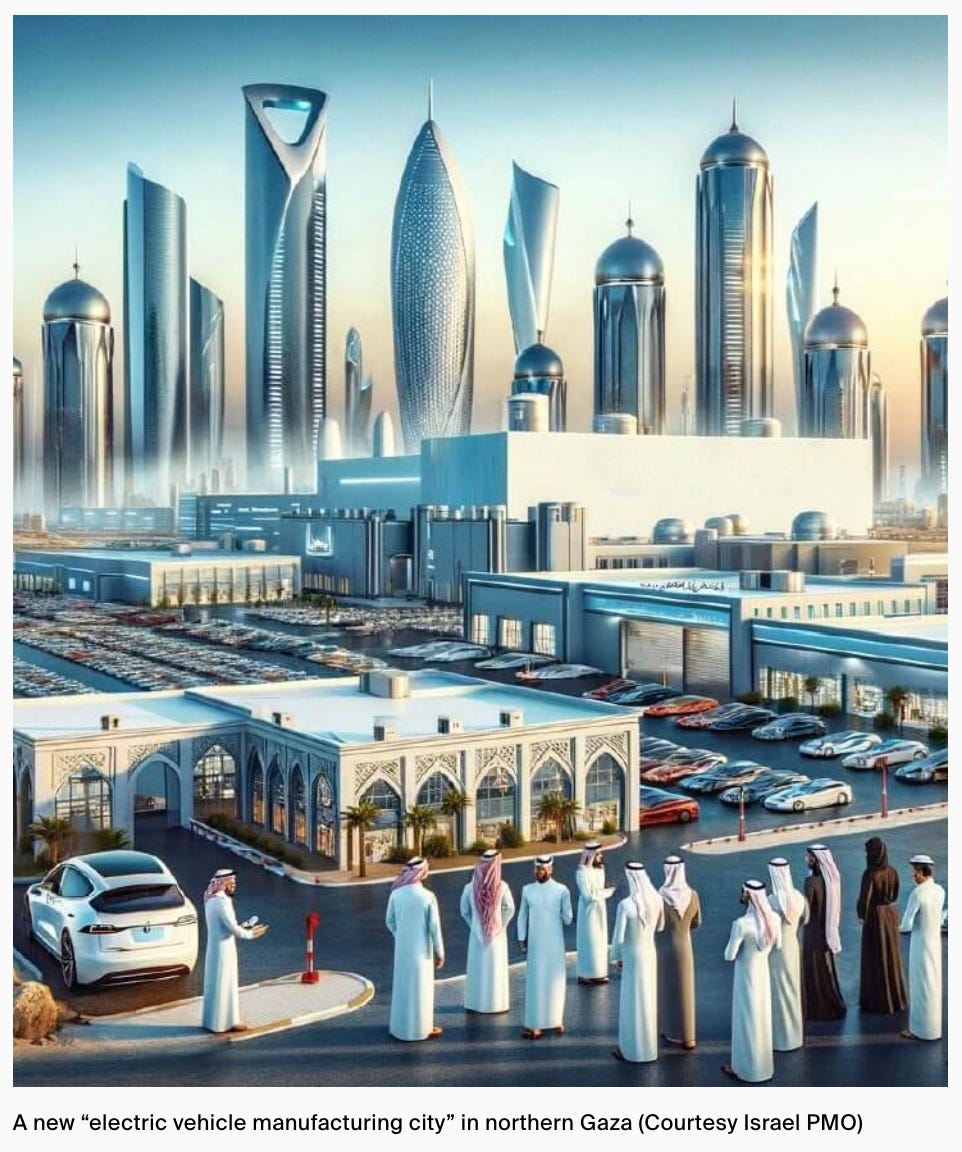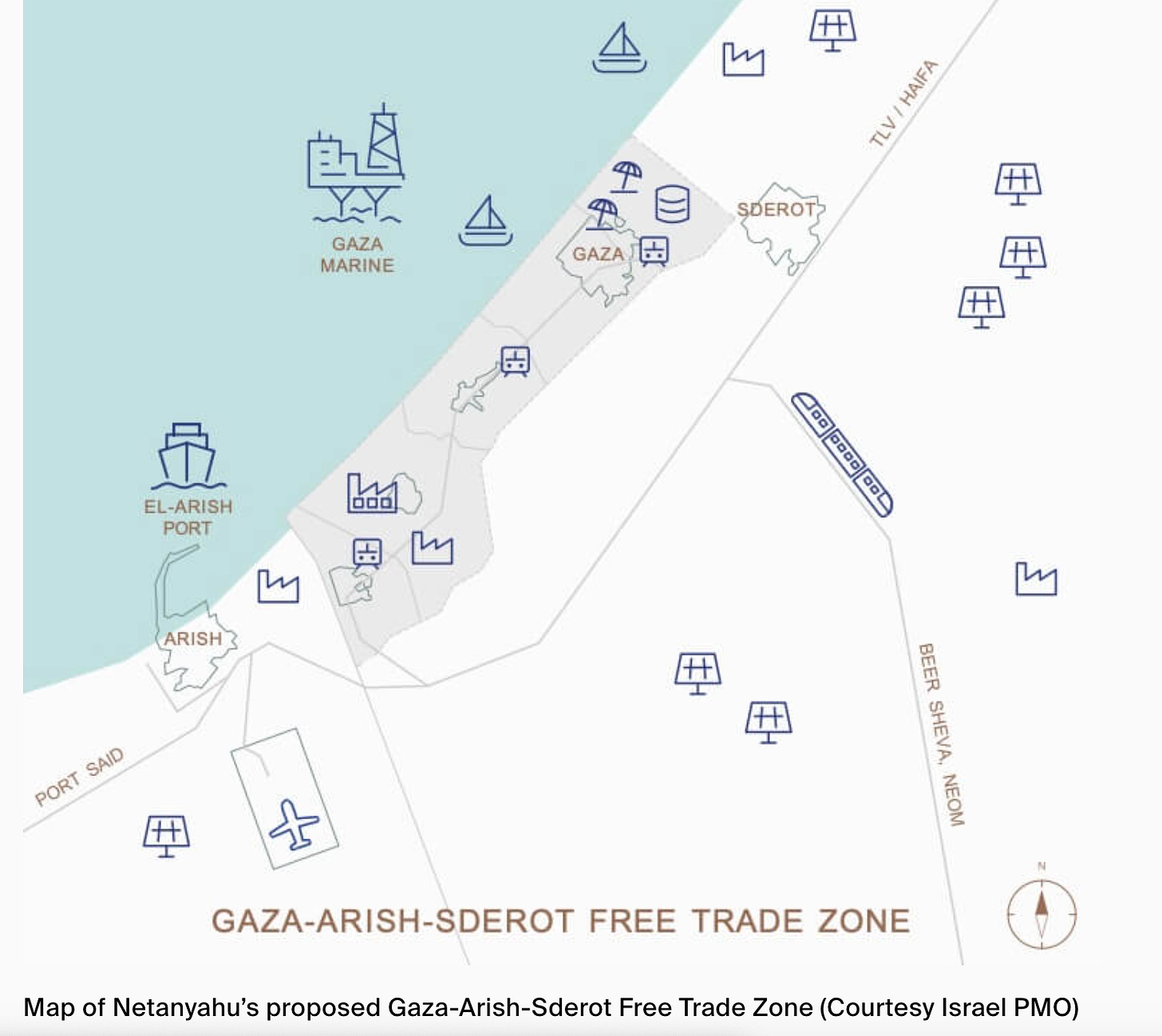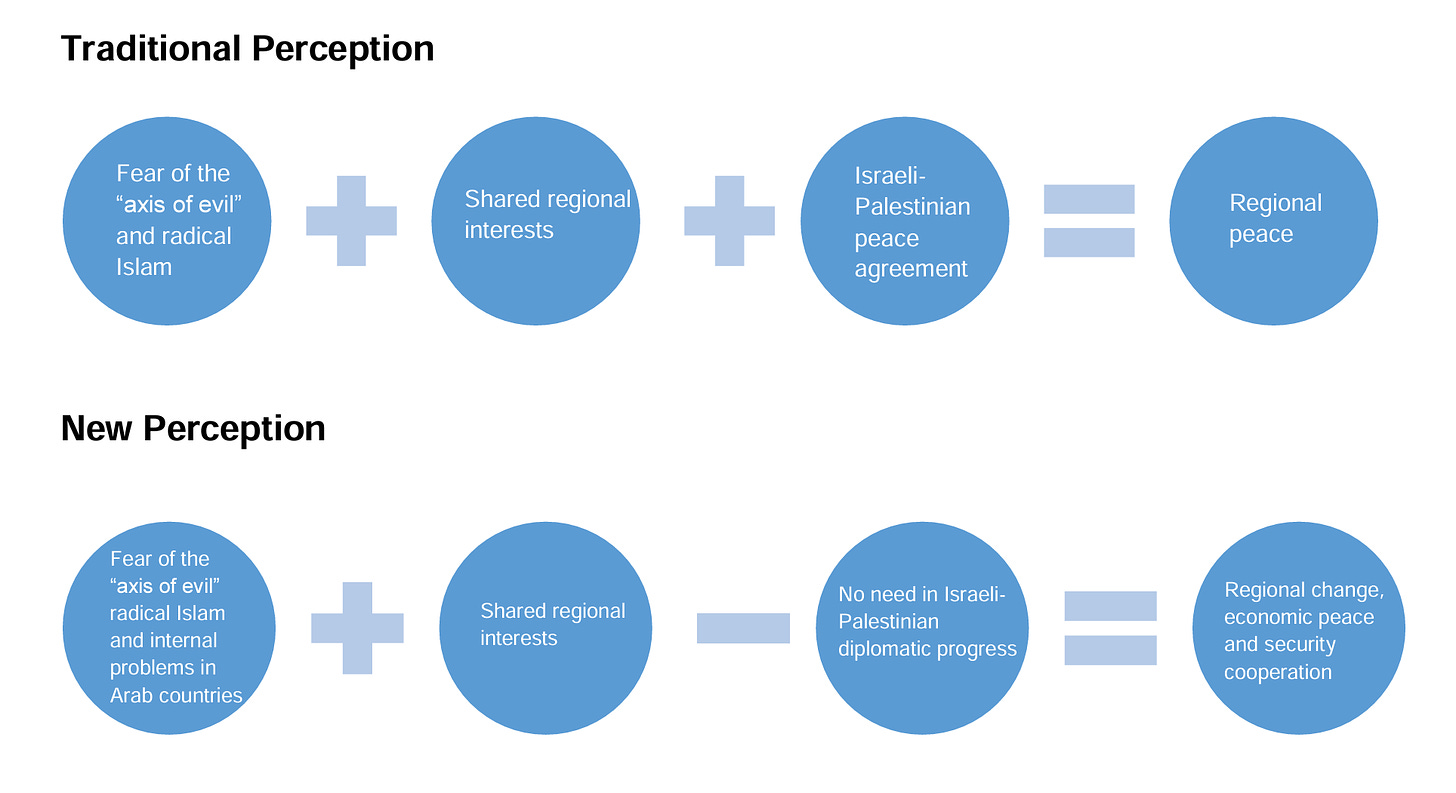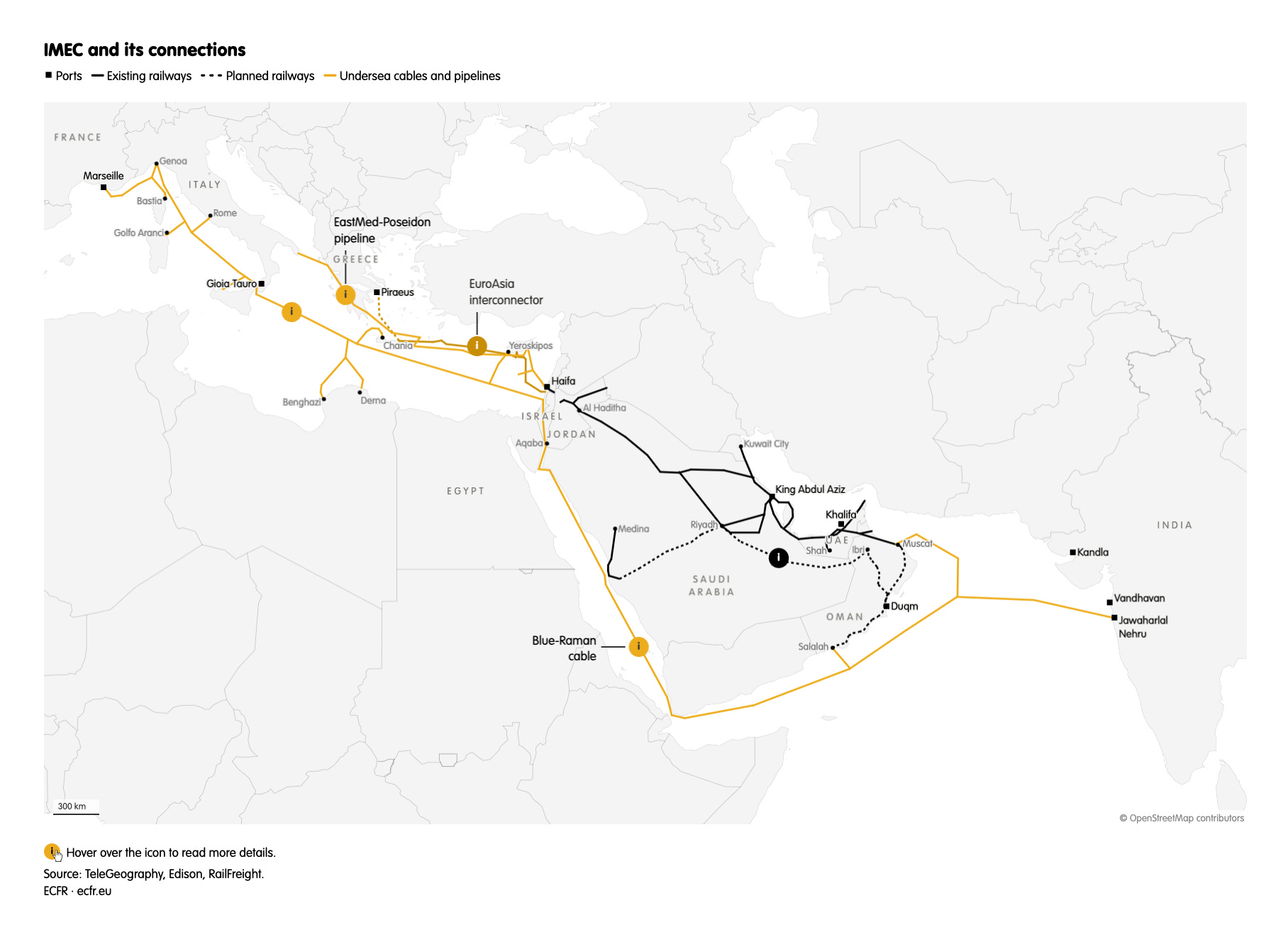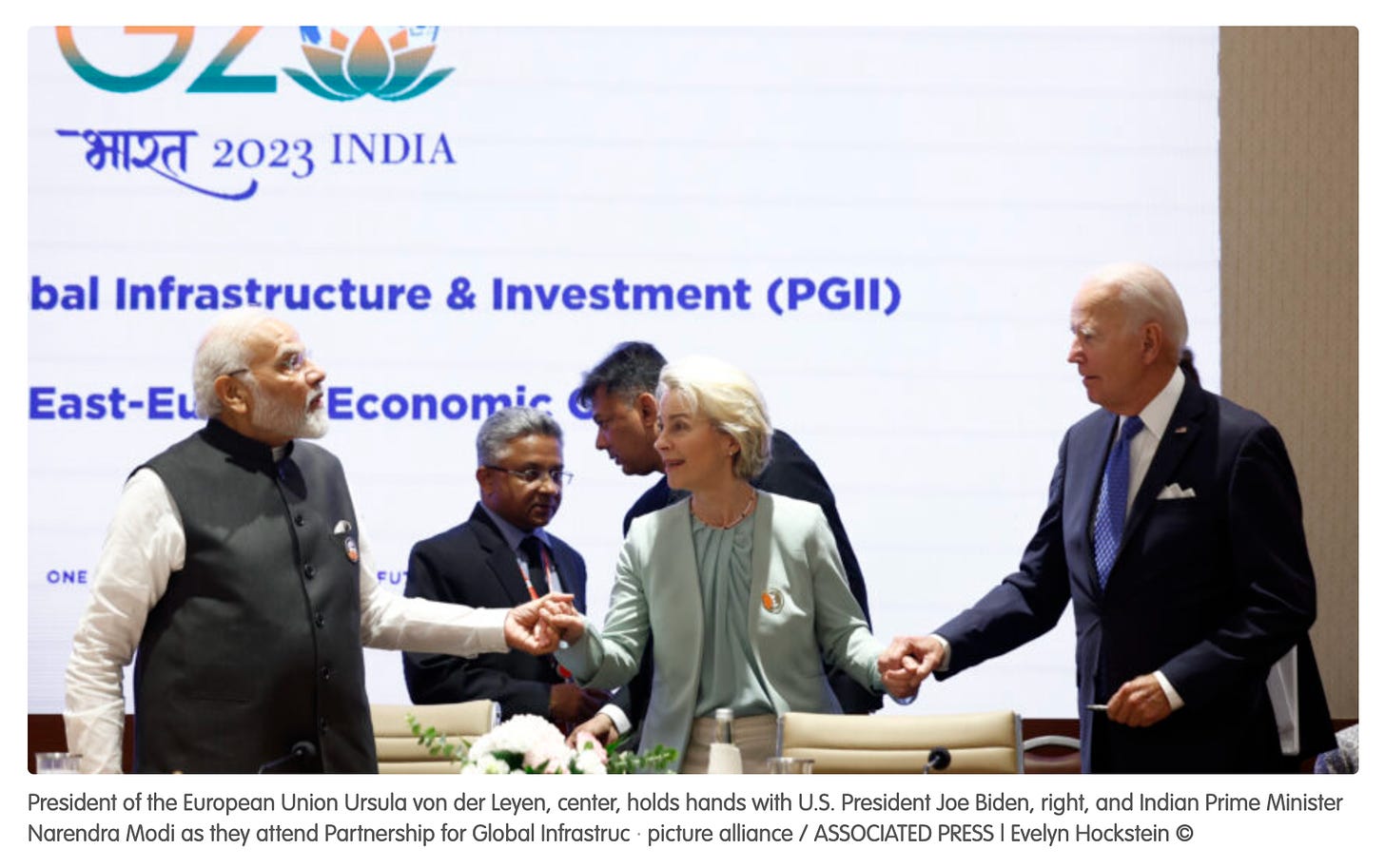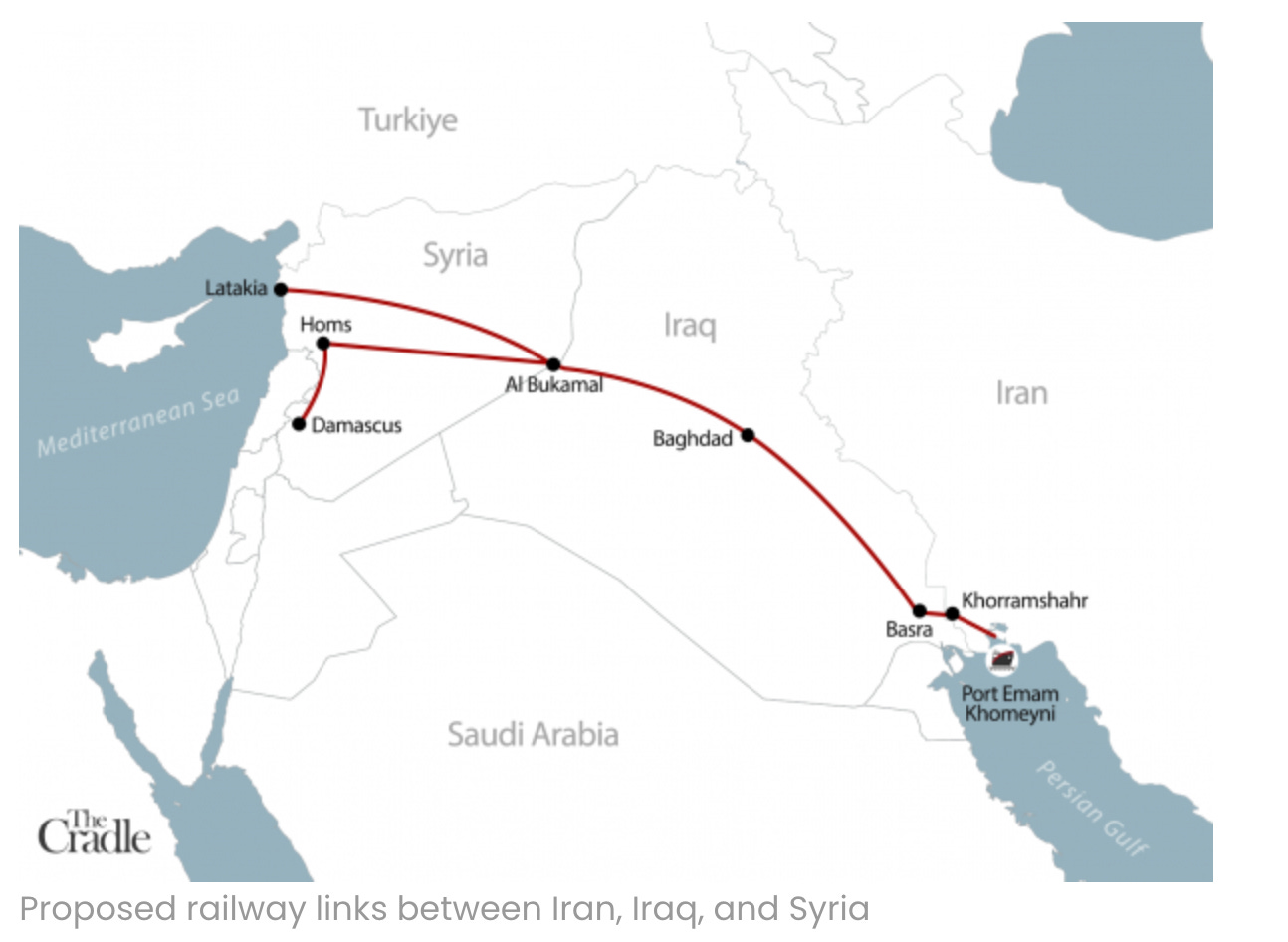Chartbook 284 Gaza: "the decade after" - the surreal geoeconomic imaginary of Netanyahu's "economic peace"
I have to admit, when I first saw the image, I thought it must be a hoax.
Source: Archpaper & PM Office of Israel
Skyscrapers, solar power plants, container ships, oil rigs off shore - a vision of idealized urban and rural settlement, generated by AI, picturing a wealthy, intensively -managed city state - think Singapore or Abu Dhabi - but with a vaguely familiar geography.
No it is not a hoax. This is the Gaza strip in 2035, as envisioned by the Office of Israeli Prime Minister of Netanyahu, eight months into a brutal war of retaliation against the Hamas attack of October 7th. On the land cleared by the displacement of millions and the killing of over 35,000 Palestinians, on a densely populated urban space that the IDF has reduced to rubble and famine, Netanyahu’s planners and their AI graphics imagine a 141 square mile free trade zone. This would bracket Gaza between the El-Arish Port to Gaza’s south in Egypt’s Sinai Peninsula and Sderot, an Israeli city north of Gaza.
First circulated internally in December 2023, the Israeli government went public with its long-range plans in early May 2024, as it faced pressure to spell out the end game. What it envisions is not the kind of the emergency reconstruction prepared by the UN, which right now is focused on a decade-long timeline for clearing unexploded ordinance and 37 millions of tons of rubble, costed to the tune of $40–50 billion. Netanyahu’s Gaza 2035 is a plan, to complete the erasure of Gaza. In it place the Israeli government envisions a mega-rich, clone of a globalized commercial and industrial city, somewhere between Chicago - what historian William Cronon described as Nature’s Metropolis - and Dubai.
As in many previous historical instances, it will be total destruction that clears the way for the rebirth of Gaza in his historical role, as a key Mediterranean entrepôt. As Netanyahu himself observes, Gaza 2035 entails “rebuilding from nothing”. That void is what the IDF is creating with its daily work of destruction.
A tabula rasa is, literally translated, a scraped tablet. After the scraping being done by the Israeli military will come the building of energy systems (oil and gas rigs and solar panels) and infrastructure (ports, airports and railways) that will move Gaza “from crisis to prosperity.”
But who or what will manage and govern this enterprise of clearance and reconstruction? “Under the auspices of Gaza 2035, the new free trade zone would be administered by Israel, Egypt, and what the Israeli Prime Minister calls the Gaza Rehabilitation Authority (GRA)—a proposed Palestinian-run agency that would oversee reconstruction in Gaza and “manage the Strip’s finances.”
In other words there will be thriving commercial center, but no longer a Palestinian political entity.
And Netanyahu is thinking big. If what he euphemistically refers to as a “Marshall Plan” in Gaza is successful, a similar model could be applied throughout the crisis-ridden region. Administered free trade zones set within regional political mandates could be constructed in “Yemen, Syria, and Lebanon.”
There is even a time line. For the first year after the end of fighting. Action in Gaza would focus on “Humanitarian Aid”, “deradicalise” Gaza and eradicate Hamas. However that is imagined.
As the Arch Paper report summarizes it:
The second stage would last between 5 to 10 years, during which Saudi Arabia, UAE, Egypt, Bahrain, Jordan, and Morocco would “supervise” Gaza’s reconstruction. The final stage would be when Palestine signs the Abraham Accords signaling “Palestinian self-rule,” albeit without statehood.
Whilst the politics are intentionally blurry, what is not, is the physical program of reconstruction. Gaza 2035 is all about the infrastructure. Railway services would connect the new city to Alexandria, Egypt and a North-South rail connection would link it to NEOM— the dreamland that Saudi’ Arabia’s MBS is planning in the desert roughly 130 miles south of Rafah. Netanyahu’s office goes on to imagine opportunities for “tech companies, factories, and “electric-vehicle manufacturing cities” all centered on the Gaza-Arish-Sderot Free Trade Zone.
If this all of this sounds fantastical, it actually has pedigree in Netanyahu’s long-standing vision of an “economic peace” that will normalize relations with the rich Arab states of the region on an economic basis, allowing the Palestinian question to be by-passed.
Source: Benziman 2018
As Mohamad Hasan Sweidan pointed out in The Cradle weeks before the Gaza war erupted, railway diplomacy is a favored domain for Israeli thinking about regional stabilization and hegemony:
Since 2017, under an initiative known as “Tracks for Regional Peace,” Israel has been trying to promote a railway project linking the port of Haifa with Persian Gulf states, including the UAE. This venture, which has already been set in motion, gathered greater significance following the normalization agreement between Abu Dhabi and Tel Aviv in 2020. In July, it was reported that Israel and the US were working on a plan for a land connection project for trucks traveling between Israel and the UAE via Jordan and Saudi Arabia. The two projects together intend to connect the Mediterranean Sea and the Persian Gulf.
Likkud politician Yisrael Katz - then Tranport Minister, later energy minister and now Netanyahu’s willing accomplice as foreign minister - has been a long-time spokesman for the vision, which follows the historic outline of imperial-era infrastructure construction. In the current era it has the signal advantage of avoiding both the Persian gulf and the narrow entrance to the Red Sea.
And this vision is not confined to Israeli strategists bent on neutralizing the Palestinian issue. The Gulf Cooperation Council has long envisioned a railway network connecting the region extending over 2100 km from the State of Kuwait to the Sultanate of Oman, passing through Dammam in Saudi Arabia, to the Bahraini capital, Manama.
This is the new geoeconomics of our era. Vast visions of transport, infrastructure and logistics energized and inspired by a mixture of commercial interest, technological fascination and geopolitical rivalry. Given its physical properties, infrastructure, is a preferred tool of the rich and the powerful. They selectively lock in political and geopolitical conflicts, giving them monumental form, whilst suppressing and concreting over the most intractable issues, e.g. the Palestinian question. These power moves are both massively political, defining who is in and who is out, and aggressively anti-political at one and the same time. Once there is a train and a train that runs on time, the hope is that other questions will seem like irrelevancies. So powerful is this idea that the promise itself has effects. You don’t even have to lay the train lines. The promise itself has effects. Actually building and operating trains is another matter altogether and comes with its own risks.
Infrastructure projects always beg the question of interconnection. Who ties in, who is compatible and who is not? The Arab-Israeli Tracks for Peace project may be distinctively regional, but it segues all too neatly into an even bigger scheme - the India-Middle East-Europe Economic Corridor (IMEC) that was launched with fanfare at the G20 hosted by India’s PM Modi in September 2023. As Mohamad Hasan Sweidan puts it in an other useful Cradle write-up:
During the G20 summit last September, US President Joe Biden announced the IMEC initiative, which would involve the participation of India, Saudi Arabia, and the UAE, along with Israel, France, Germany, Italy, and the United States. According to a White House statement, the envisioned trade corridor will feature a rail line, clean hydrogen pipelines, and economic zones stretching from India through the UAE, Saudi Arabia, Jordan, and Israel to the port of Piraeus in Greece.
The plan would serve both to tie India to Europe and the West and to place Israel at the hub of regional transport infrastructure.
As a comprehensive assessment of IMEC by Alberto Rizzi for the ECFR puts it:
The (IMEC) memorandum was light on detail, but the corridor seemed to have the remarkable ability to fit well in each participant’s strategic agenda. It would serve the US in its rivalry with China and its goal to normalise relations between Saudi Arabia and Israel. In the context of Russia’s war against Ukraine, it would enhance Europe’s economic and energy security and help it strengthen ties with the global south. IMEC would also contribute to the diversification of Gulf states’ energy markets and their mission to act as a bridge between East and West. Finally, it would help India play a greater role in global value chains and escape Beijing’s encirclement. European Commission president Ursula von der Leyen hailed the pact as “nothing less than historic”. India’s prime minister Narendra Modi said IMEC would be “the basis of world trade for years to come”, while US president Joe Biden called it “a really big deal.” Saudi Arabia’s Crown Prince Mohammed bin Salman echoed Biden almost verbatim, stating “it is a big deal for us, and for Europe [and] for India”.
As Rizzi points out:
The agreement to establish IMEC was reached largely thanks to the Biden administration’s diplomatic efforts, and the project builds on various US interests. Firstly, IMEC reflects the United States’ goal to stabilise the Middle East and sustain the momentum of the Abraham Accords between Israel and Arab countries. It also aims to contain the diplomatic influence of China in the region, which Beijing acquired after brokering a deal between rivals Iran and Saudi Arabia in 2023.
In the Middle East, however, global power politics is always refracted and multiplied through regional rivalries. For Saudi and the UAE, the stakes in IMEC are as much about Iran as about China or Israel. And the GCC-Israel-IMEC railway project has a direct counterpart in the so-called “Railway of Resistance” that seeks to tie together the disconnected and dilapidated railway systems of Iran, Iraq and Syria, to link Iran’s Port Emam Khomeyni on the Gulf to the Mediterranean at Latakia, the Syrian port city where Russia has one of its major emplacements in the region.
Once again Mohamad Hasan Sweidan was on the case back in May 2023 at The Cradle:
In July 2018, Saeed Rasouli, head of the Islamic Republic of Iran Railways (RAI), announced the country’s intention to construct a railway line connecting the Persian Gulf to the Mediterranean Sea … The concept of a railway link between Iran and Iraq emerged over a decade ago. In 2011, Iran completed the 17-kilometer Khorramshahr-Shalmanjah railway, which aimed to connect Iran's railways to the city of Basra. Subsequently, in 2014, a memorandum of understanding (MoU) was signed between Tehran and Baghdad to construct the Shalamjah-Basra line. As per the agreement, Iran was responsible for designing and building a bridge over the Arvand River, while the Iraqi side pledged to construct a 32-kilometer railway line from the Shalamjah border to the Basra railway station within Iraqi territory. … Iranian official sources stated that this railway would contribute to Syria's reconstruction efforts, bolster the transport sector, and facilitate religious tourism between Iran, Iraq and Syria. … During the visit of former Iranian President Hassan Rouhani to Iraq in March 2019, a memorandum of understanding on the project was signed between Tehran and Baghdad. However, despite the agreements, the Iraqi side has faced economic challenges and a lack of funds, resulting in a delay in the construction of the railway. Although the rail line between Iran and Iraq will only span 32 km and cost approximately $120 million, divided equally, its significance extends far beyond its length. It will serve as the sole railway connection between the two countries and play a crucial role in improving communication throughout the wider region by linking China’s Belt and Road Initiative (BRI) lines to Iraq via Iran. Once completed, the project will enable Iraq to easily connect to Iran's extensive railway network, which extends to Iran's eastern border. This linkage will open pathways for Baghdad to connect with Afghanistan, Pakistan, China, the Caucasus, Central Asia, and the Far East. Moreover, in the future, the project positions Iraq as a transit route for trade between the Arab countries of the Persian Gulf region and Central Asia, as well as Russia. Incidentally, Iran and Russia have just inked an agreement to establish a railway connecting the Iranian cities of Astara with Rasht, as part of the International North–South Transport Corridor.
Given the stakes involved, infrastructure deals of this type involve a lot of hype, long-range and slow-moving bargaining and intense rivalries. In the case of the Iran-Iraq link, it is not simply the cost, but Iraqi interests backing their country's “Dry Canal” project that resist the priority given to the Iranian rail vision. The rival Iraqi interests favor connecting what they call the Grand Port of Faw in Basra province to the land route to the Mediterranean.
In an era of fast-moving polycrisis, infrastructure projects have an ambiguous temporality.
On the one hand they are vulnerable to sudden shocks. The grand IMEC deal was announced by the White House on 9 September 2023 less than a month before the bloody Hamas attack on the Israeli settlements around Gaza. The violence of October 7 and the even greater destruction that followed have shaken world politics. It is that which renders Netanyahu’s vision of Gaza 2035 so grotesque. The response from the UAE in May 2024 was to reject the Israeli vision for Gaza’s future out of hand.
On the other hand, the fact that the Israeli’s prime ministers office returns to a vision rooted in geography, commerce and logistics has its own logic. It takes truly perverse politics to prevent Gaza from serving as a transport and commercial hub. Conversely, the Persian Gulf is a choke point so significant that it forces all the players in the region to look for “optionality”. If this be by means of some kind of deal with Israel, it may be a price worth paying. Israel does have real wealth and technological clout to offer.
As Rizzi comments, Israel’s decision to massively escalate the violence in Gaza puts the possibility of cooperation around the IMEC project in question. But by the same token, the mounting uncertainty supercharges the logic of mutual threats by which decision-makers in the “West” argue that they “must” counter Russian and Chinese initiatives, furthering stoking the rivalry and spawning more and more complex schemes. Geopolitical decision-makers want optionality and coalitions are easily built around the idea of large-scale investment in futuristic infrastructure, including the financial interests that might broker the deals. As Daniela Gabor has long argued, the promise of financializing infrastructure is one of the keys to what she calls the “Wall Street consensus”. This creates momentum.
As Rizzi points out:
Despite the huge challenges the instability in the Middle East presents, the war in Gaza and its fallout have not changed the long-term strategic and economic goals of the IMEC participants. February 2024 saw India and the UAE sign the first formal agreement on the corridor’s development and France’s president Emmanuel Macron appoint a special envoy on IMEC. At the Raisina Dialogue in New Delhi later that month, the Greek prime minister Kyriakos Mitsotakis stressed the importance of the corridor and the need to better connect the EU with India. As Modi said at Raisina, “this is an inter-generational project, and it would be a mistake to see it through the prism of any one event or conflict.”
Even as mere pipedreams, glitzy projects like BRI, Gaza 2035, IMEC, or the “Railway of Resistance” serve a purpose. As I argued in relation to the Just Energy Transition Partnerships, much of policy-making has a self-soothing quality. In other cases it may serve the purpose of stoking tension, creating rivalries and generating the call for further projects. Or visions like Gaza 2035 may act as an diversion, conjuring up harmonious regional infrastructure visions, whilst settlers and their bulldozers move in on the ground.
Action is the game changer. Mass destruction, as in Gaza, or giant building projects, like port systems and fiber optic networks, shifts politics into a new mode. Action, whether it be earth-moving, people-moving or the actual investment of funds, creates physical and technological realities. There is no promise of success or efficiency . Many infrastructure projects are white elephants. But whatever the assessment in terms of “success or failure”, the move from the drawing board to action impacts lives, sometimes for the good, often in disruptive and even deadly ways. In any case, they move from the hypothetical horizon of the future to the concrete immediacy of how life is to go on. And that is the question in Gaza.
In the coming months, as the IDF completes its work of destruction, this is increasingly going to be the question. What to do after this terrible violence? What are the millions of survivors to do? Where and how to make their lives? The grotesquely manicured plans for Gaza 2035 are not an answer to those existential questions. They are a glossy hallucination, which did not even quiet the divided Israeli cabinet for more than a few days. But don’t count them out. They will be back.
***
Thank you for reading Chartbook Newsletter. It is rewarding to write. I love sending it out for free to readers around the world. But it takes a lot of work. What sustains the effort are voluntary subscriptions from paying supporters. If you are enjoying the newsletter and would like to join the group of supporters click below. As a token of appreciation you will receive the full Top Links emails several times per week.




